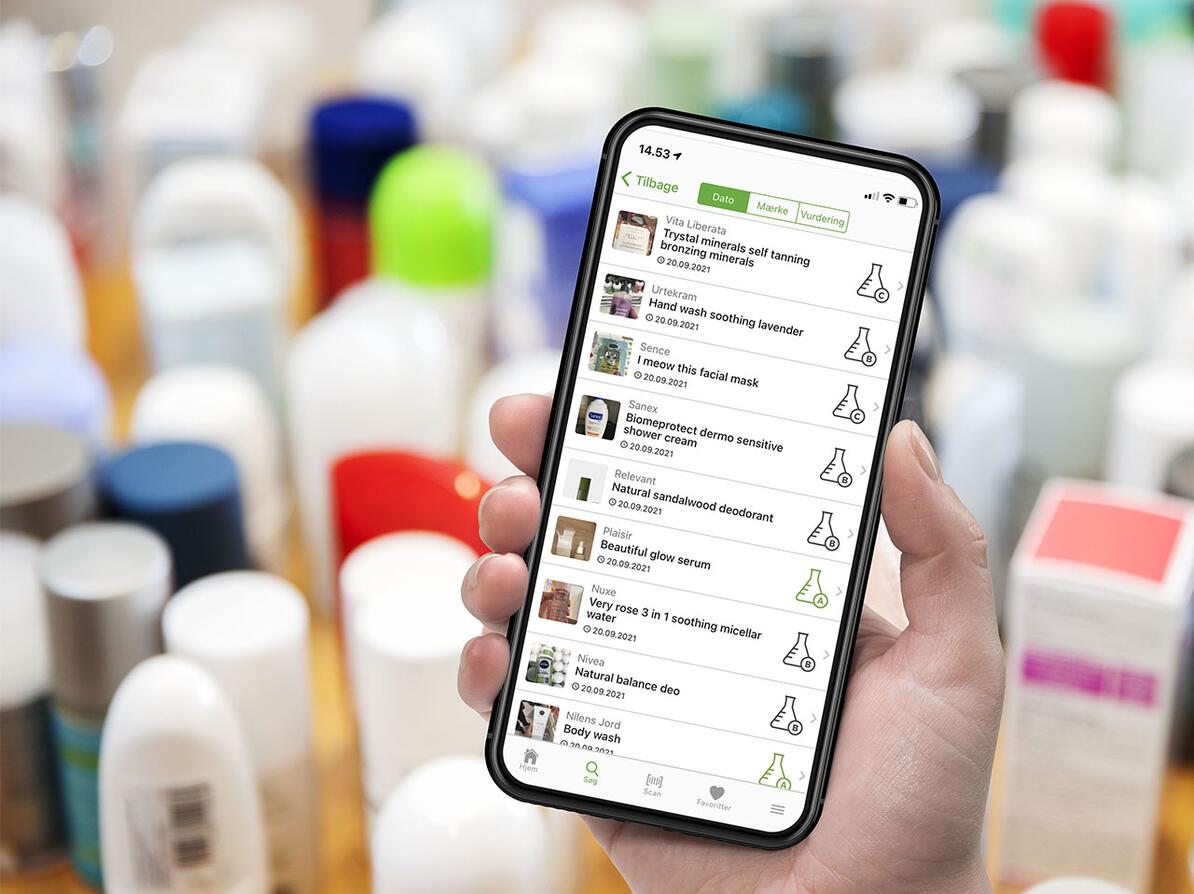Substances from new list of endocrine disruptors are widely used in cosmetics
A new list of endocrine disruptors from 5 EU member state authorities’ have been included in the assessment of cosmetics done by The Danish Consumer Council THINK Chemicals. Some of the substances are widely used in cosmetics.

Cosmetic app: New list of endocrine disruptors gives new ratings
With the app ‘Kemiluppen’ – that roughly translates to ‘The Chemical Magnifying glass’ - Danish consumers can check their favorite cream, shampoo or deodorant for unwanted ingredients. This includes substances which are suspected of being endocrine disrupting.
Regularly scientists, authorities or other relevant stakeholders release new knowledge about the ingredients in cosmetics and personal care products.
The Danish Consumer Council THINK Chemicals runs ‘Kemiluppen’ and therefore we regularly update the assessments of the ingredients in the more than 18,000 products rated in the app. The updates assure that new and relevant product information is provided to the consumers.
In the beginning of June 2020, a lot of products got a new rating in ‘Kemiluppen’. This happened after 5 European authorities listed a number of substances as suspected endocrine disruptors.
Hormone Disruptors: New lists released
Recently new lists of endocrine disruptors were released.
The Danish Environmental Protection Agency has prepared a list of endocrine disruptors in collaboration with authorities from France, Belgium, Sweden and the Netherlands.
The list consists of approximately 100 substances. However, only some of the substances are used in cosmetics and personal care products.
Furthermore, last year the EU Commission's priority list of potentially endocrine disruptors in cosmetics and personal care products was published. There are 28 substances on this list.
Complies with the law: Problematic substances are still legal to use in cosmetics
Some of the substances on the two lists have already been identified as endocrine disruptors in EU.
Other substances are on the lists based on a suspicion that they have endocrine disrupting effects in humans or in the environment and therefore the substances are now under further ED-evaluation within the EU system.
Those substances from the lists found in cosmetics and personal care products are all legal to use in these products.
Unwanted Chemicals: Many already included in the evaluation of cosmetics
Many of the substances on the new lists are already considered "suspected endocrine disruptors" by the Danish Consumer Council THINK Chemicals.
This applies, for example, to the following substances:
- Ethylhexyl methoxycinnamate (uv-filter)
- Benzophenone-3 (uv- filter)
- Butyl and Propylparaben (preservative)
- Resorcinol (colourant)
- BHT (anti-oxidant)
- Salicylic acid (exfoliant)
Among other negatives effects, authorities and researchers have previously evaluated these substances to be endocrine disruptors.
Hormone Disruptors: Several new substances
The new lists of endocrine disruptors also cover a number of widely used ingredients that The Danish Consumer Council THINK Chemicals has not assessed until June 2020.
This applies, for example, to these substances:
- Octocrylene (uv-filter)
- Homosalate (uv-filter)
- Ethylhexyl salicylate (uv-filter)
- Benzyl salicylate (perfuming substance)
At the bottom of the article, you can find which other new substances that the Danish Consumer Council THINK Chemicals are now considering suspected hormone disruptors.
Products containing one of these substances not previously assessed as suspected endocrine disruptors will now get the lowest chemical rating (C) regardless of their previous rating.
Cosmetics: Suspected substances in many products
The ‘Kemiluppen’ app contains evaluation of the ingredients of more than 18,000 cosmetic and personal care products. More than 3,000 of them contained one or more of the new suspected endocrine disruptors.
The perfuming substance, benzyl salicylate, was found in around 11% of the evaluated cosmetic products and it was the most abundant of the new substances. The substance is used in almost all types of cosmetic products.
Octocrylene is the most widespread of the new UV-filters on the lists. It is mainly present in sunprotection products but also in other products with UV-protection like face creams, BB creams, lipbalms, foundations and the like.
In total, now more than 6,500 – or what equals 35% - of the products in ‘Kemiluppen’ contains one or more suspected endocrine disruptor if considering both the old and new substances suspected of being endocrine disrupting.
The Danish Consumer Council THINK Chemicals: It is important that new knowledge reach the consumers
“A large number of substances are or are suspected of being endocrine disruptors. The list is growing, and at the Danish Consumer Council THINK Chemicals, we are constantly monitoring what scientists and authorities report on chemicals in care products and other consumer products. We strive to incorporate the new knowledge into our work and communicate it to consumers in a useful way. This means that consumers will experience products that previously performed well in our app ‘Kemiluppen’, now these products receive a lower rating. However, it is more important for us to provide up-to-dated information on the products, rather than preventing products from having a change in their rating. ”
Claus Jørgensen, project manager, The Danish Consumer Council THINK Chemicals
General advice
-
Do you already have products containing some of the substances? It is not the individual product itself, which is a problem. Our total exposure to endocrine disruptors is what worries scientists.
Therefore, you do not need to throw the products containing the suspected endocrine disrupting chemicals out if you already have the products on the shelf at home.
However, if you want to reduce your overall exposure to endocrine disruptors in the future you can choose personal care products without these substances.
-
These new substances are now included in the assessments of cosmetics by the Danish Consumer Council THINK Chemicals:
- Homosalate - UV-filter
- Octocrylene - UV-filter
- Ethylhexyl salicylate - UV-filter
- Isoamyl p-methoxycinnamate - UV-filter
- Benzophenone-4 - UV-filter
- Benzophenone-5– UV-filter
- Benzyl salicylate - perfume
- Kojic acid - antioxidant
- Genistein - skin care
The substances are either on the EU Commission's priority list of potentially endocrine disruptors in cosmetics and personal care products or on the joint list of endocrine disruptors prepared by the Danish Environmental Protection Agency in collaboration with authorities from France, Belgium, Sweden and the Netherlands.
In the future, products containing these substances will receive the lowest chemical rating, (C).
‘Kemiluppen’ has previously evaluated the fragrance benzyl salicylate with a B flask because it is allergenic. We have not previously evaluated the other substances.
EU Commission's priority list of potential endocrine disruptors in cosmetics and care products
